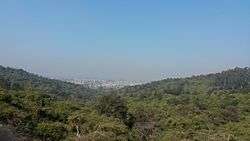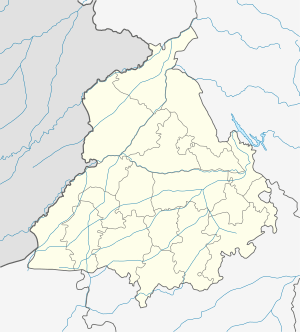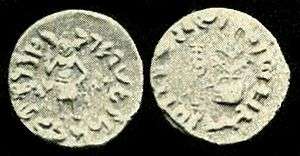Pathankot
| Pathankot | |
|---|---|
 Pathankot City | |
 Pathankot Location in Punjab, India  Pathankot Pathankot (India) | |
| Coordinates: 32°16′01″N 75°36′00″E / 32.266814°N 75.6°ECoordinates: 32°16′01″N 75°36′00″E / 32.266814°N 75.6°E | |
| Country | India |
| State | Punjab |
| District | Pathankot |
| Government | |
| • Body | district |
| • Deputy Commissioner | Shri Amit Kumar, I A S. |
| • Member of Parliament | Sunil Jhakkar (INC) |
| Area rank | 9th |
| Elevation | 332 m (1,089 ft) |
| Population (2011) | |
| • Total | 156,306 |
| Time zone | UTC+5:30 (IST) |
| Pin Code | 145001 |
| Telephone code | 0186 |
| Vehicle registration | PB-35 |
| Largest city | Pathankot |
| Website | https://pathankot.nic.in/ |
Pathankot is a city in the Punjab state of India. Pathankot district is a border district which shares international border with Pakistan on its West. Pathankot was officially declared as District of Punjab state on 27 July 2011 (Previously it was a Tehsil of Gurdaspur district, Punjab). Pathankot district is at the meeting point of the three northern states of India -- Punjab, Himachal Pradesh and Jammu & Kashmir. Due to its location, Pathankot serves as a travel hub for those three northerly states.
Pathankot is the 9th most populous city in the state of Punjab. After Ludhiana, Amritsar & Jalandhar, Patiala, Bhatinda, Pathankot is 6th Largest and populous if SUB-URBAN areas like Sarna (5 km from ISBT), Mamun(5 km from ISBT), Jugial(9 km from ISBT) are included.Pathankot along with its nearby twin city of Kathua in J&K constitute the Kathua-Pathankot urban area.
Situated in the picturesque foothills of Kangra and Dalhousie, with the river Chakki flowing close by, the city is often used as a rest-stop before heading into the mountains of Jammu and Kashmir, Dalhousie, Chamba, Kangra, Dharamshala, Mcleodganj, Jwalaji, Chintpurni and deep into the Himalayas. Pathankot also serves as education hub for the nearby areas of Jammu & Kashmir and Himachal Pradesh. Many students basically from rural areas of these states come to study here.
History
Pathankot is an ancient city and has historical significance. From various accounts; It may be believed that Audumbara was the name of it. Numerous coins of great antiquity found at Pathankot prove that it is one of the oldest sites in the Punjab and it must always have been a place of great significance situated as it in the foot of the hills.

Obv: Standing figure, probably of Vishvamitra, Kharoshthi legend, around: Mahadevasa Dharaghoshasa/Odumbarisa "Great Lord King Dharaghosha/Prince of Audumabara", across: Viçvamitra "Vishvamitra".
Rev: Trident battle-axe, tree with railing, Brahmi legend identical in content to the obverse.[1]
Pathankot was the capital of Nurpur State and its name was changed to Dhameri (Nurpur) in the time of Akbar. The Pathania clan of Rajput derived its name from ancient name of Pathankot which was Paithan at that time.
After independence
After the independence of India, Pathankot, has developed as an important township in many aspects.
The strategic point of location has prompted the establishment of an army presence and air force station for the defence of India. The Indian army and Indian air force have successfully defended the territory of India in times of war.
Traders supplying the army's needs have also increased their business. After the partition of India, as in most other North Indian citizens a huge number of people came from West Punjab (newly formed Pakistan) and settled in and around Pathankot.
Most of them started trades of different kinds, contributed to the growth of the city and area and presently many of those businesses have grown into large business horses.
Geography

Pathankot has an average elevation of 332 metres (1,089 ft). It is a green town surrounded by the Ravi and Chakki rivers. Shiwalik foothills on the south and east and snow-capped Himalayas in the back drop in north.
Average temperature
- Spring: The climate remains the most enjoyable part of the year during the spring season (from mid-February to mid-April). Temperatures vary between (max) 16 °C to 25 °C and (min) 9 °C to 18 °C.
- Autumn: In autumn (from Mid-September to mid November.), the temperature may rise to a maximum of 30 °C. Temperatures usually remain between 16° to 27° in autumn. The minimum temperature is around 11 °C.
- Summer: The temperature in summer (from Mid-May to Mid-June) may rise to a maximum of 46 °C (rarely). Temperatures generally remain between 34 °C to 46 °C (91 – 115F).
- Monsoon: During monsoon(from mid-June to mid-September), Pathankot receives moderate to heavy rainfall and sometimes heavy to very heavy rainfall (generally during the month of August or September). Usually, the rain bearing monsoon winds blow from south-west/ south-east. Mostly, the city receives heavy rain from south (which is mainly a persistent rain) but it generally receives most of its rain during monsoon either from North-west or North-east. Maximum amount of rain received by the city of Pathankot during monsoon season is 195.5 mm in a single day.
- Winter: Winters (November to Mid-March) are mild but it can sometimes get quite chilly in Pathankot. Average temperatures in the winter remain at (max) 7 °C to 15 °C and (min) 0 °C to 8 °C. Rain usually comes from the west during winters and it is usually a persistent rain for 2–3 days with sometimes hail-storms. Pathankot experienced snowfall in 2012 after almost 55 years.
| Climate data for Pathankot | |||||||||||||
|---|---|---|---|---|---|---|---|---|---|---|---|---|---|
| Month | Jan | Feb | Mar | Apr | May | Jun | Jul | Aug | Sep | Oct | Nov | Dec | Year |
| Record high °C (°F) | 28 (82) |
29 (84) |
35 (95) |
43 (109) |
46 (115) |
49 (120) |
46 (115) |
41 (106) |
40 (104) |
40 (104) |
35 (95) |
29 (84) |
49 (120) |
| Average high °C (°F) | 18 (64) |
21 (70) |
26 (79) |
33 (91) |
37 (99) |
39 (102) |
34 (93) |
33 (91) |
33 (91) |
31 (88) |
25 (77) |
19 (66) |
29 (84) |
| Average low °C (°F) | 8 (46) |
11 (52) |
16 (61) |
22 (72) |
26 (79) |
29 (84) |
28 (82) |
28 (82) |
26 (79) |
21 (70) |
14 (57) |
9 (48) |
20 (68) |
| Record low °C (°F) | −4 (25) |
0 (32) |
4 (39) |
10 (50) |
15 (59) |
19 (66) |
19 (66) |
20 (68) |
19 (66) |
9 (48) |
4 (39) |
−1 (30) |
−4 (25) |
| Average precipitation mm (inches) | 71 (2.8) |
80 (3.15) |
81 (3.19) |
46 (1.81) |
34 (1.34) |
78 (3.07) |
356 (14.02) |
370 (14.57) |
140 (5.51) |
25 (0.98) |
16 (0.63) |
38 (1.5) |
1,335 (52.57) |
| Average precipitation days | 5 | 7 | 8 | 5 | 3 | 4 | 12 | 13 | 8 | 2 | 1 | 3 | 71 |
Language
Punjabi is the most widely spoken and official language, Dogri is also spoken.
Transport
Pathankot is well connected by rail and road with the rest of the country. Pathankot is connected by a vast network of private and public-sector bus services to other cities in Punjab, Himachal Pradesh, Delhi, Haryana, Jammu and Kashmir. Important destinations include Delhi, Manali Chandigarh, Jammu, Dharamshala, Dalhousie and Amritsar. Pathankot is used as a gateway for Chamba and Kangra Valley in Himachal Pradesh and for various locations in Jammu and Kashmir like Jammu City Mansar Lake, Srinagar, Udhampur, Holy Cave at Amarnath, Patni Top and Holy Cave of Mata Vashino Devi (Katra) 155 km away from Pathankot.
One can take an auto rickshaw or a cycle rickshaw at cheap rates.
By Air
- Pathankot Airport is a domestic airport serving Pathankot with sheduled flight operations to/from New Delhi by Alliance Air under Udaan scheme.The nearest International Airport,however is located in Amritsar.The Amritsar International Airport has sheduled direct operations to cities across the globe like Birmingham, Dubai, Doha, Singapore, Kuala Lumpur among others serves the Pathankot
Train
It has direct train links with Delhi, Jammu and other Indian cities. All trains going to Jammu pass through Pathankot Cantt Station. The important trains include Rajdhani, Swaraj Express, Pooja Express, Shri Shakti Express, Andaman Express. Super fast trains do not enter Pathankot Station in City.The distance from Pathankot Junction & Pathankot Cant Railway station is just 4 km.
Pathankot Railway Station under A-category. Pathankot is a major railroad junction. Lines from Amritsar (2 hrs) and Delhi (8 hrs) merge here, and all services to Jammu (2 hrs) pass through. In addition to Pathankot station itself, there is a second station called Chakki Bank renamed Pathankot Cantt just 4 km away, which serves some express trains that do not stop in Pathankot station. Nowadays the majority of the Jammu trains stop only at Pathankot Cantt Railway Station[2] and not at Pathankot Railway Station.
Pathankot is also served by the narrow-gauge Kangra Valley Railway (a.k.a. Kangra Toy Train) built by the British, which crawls 128 km through stunning scenery to Joginder Nagar via Palampur and Kangra (near Dharamsala). However, the luxury Kangra Queen services were terminated in 2003, leaving about six departures daily of slow, often packed second class trains, taking over six hours. Bookings for these can only be done locally at Pathankot station. Some of these trains run to Baijnath Paprola and a few to Joginder Nagar. The main stations on this line include Kangra and Palampur, although Dalhousie and Dharmasala are not on the line. The town is the lower terminus of the Kangra Valley Railway, thereby connecting the mountainous regions of western Himachal Pradesh to the network of Indian Railways.
Bus
Maharana Pratap Inter State Bus Terminal Pathankot. It's close to the Pathankot Junction Railway station. Public buses to Dharamshala Dalhousie take 3–4 hours. while buses to Amritsar take 3 hours. Dalhousie famous destination for honeymoon couples is at just 80 km from Pathankot. The famous Hindu Pilgrimage Vaishno devi is just 160 km from Pathankot. Chandigarh is 4–5 hours away. It is well connected with bus services from Punjab roadways, Haryana Roadways, Himachal Roadways J&K transport, and private AC volvo buses.
One can stop over in Pathankot en route to Gurdaspur(35 km), Mukerian (40), Dharamshala (100 km), Dalhousie (100 km), Amritsar (108), Palampur (100 km), Chamba (100 km) & Jammu (100 km), Hoshiarpur (100 km), Kangra (100 km), Jalandhar (108 km), Srinagar (400 km) all in different directions from Pathankot via Jalandhar-Srinagar National highway (NH-1A), Dabwali-Pathankot National highway (NH-54) and Pathankot-Mandi National highway (NH-20).
Economy
After the liberalisation of the Indian economy, Pathankot emerged as a commercial center of wholesalers and distributors of consumer goods and services, catering to Himachal Pradesh, J&K and northwest Punjab.
Demographics
As per provisional data of 2011 census Pathankot urban agglomeration had a population of 159,909, out of which males were 84,145 and females were 75,764. The literacy rate was 88.71 per cent.[3]
Sports
The big moment of Pathankot came on 8 November 2014 when Punjab Deputy CM Sukhbir Singh Badal laid down the foundation stone for a stadium in Pathankot. Little building took place before the proclaimed completion date.[5]
Tourist places
- Mukteshwar Mahadev Temple (मुक्तेश्वर महादेव मंदिर), also known as Mukesaran Mandir, is a popular shrine of Lord Shiva and is situated 25 km from Pathankot City in Village Doong, on the bank of the Ravi River. These caves are on the way to Shahpur Kandi. It is the holy temple of the Hindu religion, where the idols of Lord Ganesha, Lord Bramha, Lord Vishnu, Lord Hanuman, and Goddess Parvati are present. This temple is considered one of the most sacred places around Pathankot. There are some caves which purportedly date to the time of the Mahabharata. According to legend, the Pandavas stayed in those caves for a night during their exile (Agayatwas). This temple is said to be 5,500 years old, dating it to the time of Mahabharata.
- Pracheen Shiv Mandir Kathgarh is one of the more famous temples in the area. Devoted to Lord Shiva and Parvati, this temple is situated 25 km from Pathankot City, 4 km from Mirthal, and 7 km from Indora on the meeting point of the Beas and the Choch rivers. The temple is built in a Roman architectural style, housing two Lingas of light grey sandy stone of 6’ and 4’7" in height having octagonal base with every side measuring 1’3" and 1’3" above the ground level, personifying Lord Shiva and Parvati respectively. These Lingas are in direction of northwest, stand 3 1/2" apart at the bottom, and incline towards each other, being just two inches away from each other at the top.
- Shahpurkandi fort is located 20 km (approximately) from Pathankot City. It was built in 1505 A.D. by a Rajput chief by the name of Jaspal Singh Pathania. It was strategically located to have control over the Kangra and Nurpur region. The fort is in ruins today, and it is famous for its temples and the view it commands over the Ravi river.
Pathankot city is surrounded by both the Shivalik range, part of which makes up the foothills of the Himalayas, and the river Chakki. Places worth visiting near Pathankot include Shahpur Kandi with a hanging rest house, Ranjit Sagar Dam which is the highest gravity dam in Asia. Madhopur (Madhopur, Punjab) head works which date back to the Mughal era. head works of Upper Bari Doab, Shahpur Kandi are the attractions of this area. Another place of interest could be Keshopur Chhamb which is home to many Migratory Birds.
- There is a fortress called the Nurpur Fort built by the Pathania Rajputs, more than 900 years ago. It was damaged due to the great earthquake which struck this region early in 1905 A.D., 25 km from Pathankot. It is quite famous in North India, and the temple inside attracts tourists from all across India. It is 25 km away from Pathankot.
- Also seek to visit Jugial Township, which is located 15 km (approx) from Pathankot. This place has greenery all around and one Shri Laxmi Narayan Mandir which is the biggest among the nearby areas.
- Asia's foremost Hydraulic Research Station at the Upper Bari Doab Canal is situated at Malikpur which is 7 km from Pathankot, where various models of Dams and Irrigation Canals are made before actual work starts upon them.
- Dalhousie is snowy in winter, and nearby Khajjiar has been described as an "Indian Switzerland" due to its scenery and activities such as balloon riding, paragliding, and horseback riding.
- For religious trips like Jwala ji (130 km), Chintpurni (130 km), Pathankot becomes an ideal place to rest before heading to the hill route the next morning. A Grand Ranjit Sagar Dam (earthen Dam made of mud and not concrete) is a 100 km water reservoir. This is the latest tourist spot of Pathankot and is in "Must Visit". Chinmayya Temple (Swami Chinmayya Nand) is also on the way to Yol, India Camp (100 km). This is the place where the German Soldiers (POW) were kept in confinement after the Second World War by the British.
- One can stop over in Pathankot en route to Dharamshala (100 km), Dalhousie (70 km), Amritsar (108), Palampur (100 km), Chamba (100 km) & Jammu (100 km), Mukerian(40 km), Hoshiarpur (100 km), Kangra (100 km), Jalandhar (108 km) all in different directions from Pathankot.
Notable people
- Vinod Khanna (MP)[6]
- Rajendar Nath Rehbar (Poet (Shaayar in Urdu) and Lyricist)
- Master Mohan Lal (Ex. MLA)
- Siddarth Kaul (Cricketer)
- Rajbeer Singh (Actor)
References
- 1 2 Ancient India, from the earliest times to the first century, A.D by Rapson, E. J. p.154
- ↑ "PTKC/Pathankot Cantt (3 PFs) Railway Station - Train Departure Timings - India Rail Info".
- ↑ "Urban Agglomerations/Cities having population 1 lakh and above" (PDF). Provisional Population Totals, Census of India 2011. Retrieved 7 July 2012.
- ↑ "Pathankot City Population Census 2011 - Punjab".
- ↑ "Five months on, work yet to begin on Pathankot stadium". http://www.tribuneindia.com/news/punjab/community/five-months-on-work-yet-to-begin-on-pathankot-stadium/60421.html. Retrieved 2016-01-02. External link in
|website=(help) - ↑ http://india.gov.in/my-government/indian-parliament/vinod-khanna
